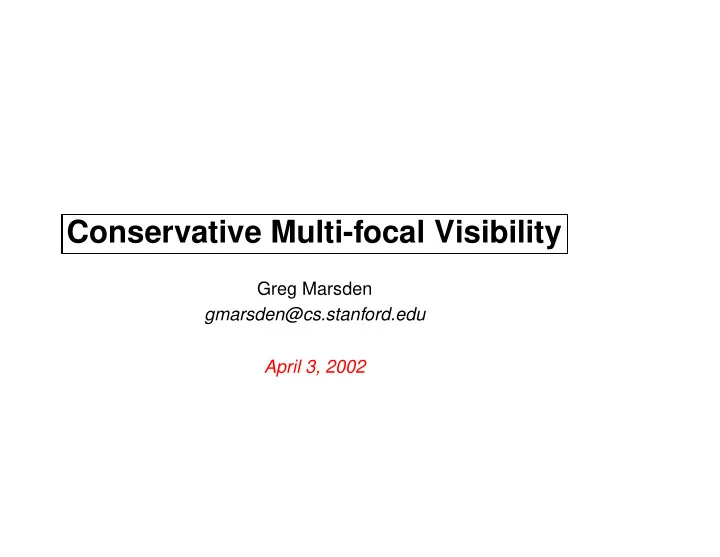

Conservative Multi-focal Visibility Greg Marsden gmarsden@cs.stanford.edu April 3, 2002
� � � Introduction New method for conservatively computing visible geometry for a vol- ume of viewpoints. Allows amortization of cost over multiple frames, running asynchronously to the graphics pipeline. Uses existing graphics hardware to accelerate visibility computation. In this method, occluded polygons are subjected to simplification using an error metric based on their ability to intercept visible rays, and not on usual geometric proximity measures 1
� � Visible surface algorithms Efficient visible surface algorithms reduce load on graphics pipeline – Z Buffer algorithm – Depth sorting – View frustum culling – BSP tree (occluder fusion) Determining what objects are occluded by a set of disconnected poly- gons for a single viewpoint is a computationally hard problem. 2
� Volume visiblility computation Notice that many viewpoints have high spatial and temporal locality: i.e. many objects perservere from one scene into the next. – Scene voxelization (imprecise) – View shafts – Cells and portals 3
� � ✁ � ✁ ✁ ✂ Viewpoint correspondence Want to take the intuition of volume visibility (locality based optimization) and make it into a technique. Define Viewpoint perspectivity as the coherence between unique view- points in viewing volume . Fix a projection plane in space. The set of all rays originating fom and passing through at a given point define a vector bundle . The collection of these bundles defines the interaction between and . Up to this point, similar to other techniques. 4
Correspondence A sample “vector bundle.” 5
✂ ✁ ✂ � ✁ ✂ � ✂ � Creating a multifocal -buffer Because we want to get an upper bound for the distance between the oc- cluder and point , the occlusion information can be conservatively stored by saving the shortest distance along a vector originating in and passing through . For the purposes of this exploration, we can get away with using the eu- clidean distance between occluding simplex and as a conservative estimate of this value (it is an interesting and untackled problem to deter- mine the shortest distance from to passing through volume ) 6
� � ✁ ✂ � ✂ � Using the multifocal -buffer To use the multifocal -buffer and ensure that the technique is conservative, calculate the maximum distance between occludee and along any ray in the bundle belonging to . Because this is a conservative test, we can get away with using the eight corners of , and use the conventional -buffer for the computation. In practice this can be further accelerated by testing cells of occlusion hierarchies (octrees/etc) instead of actual polygons. 7
Sample output: voronoi maps Gray levels indicate closest triangle feature. 8
� Sample output: distance fields Sample multifocal -buffers for 1 and 2 triangles. 9
� � � � � ✁ � � Future work Integration with graphics pipeline -buffer Further geometric optimization (simplifying projection. Interaction with dynamic models Acceleration of complex rendering effects 10
Recommend
More recommend